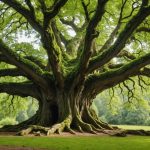Overview of Ancient Trees in the UK
Ancient trees are a vital part of the UK’s natural heritage, providing not only ecological significance but also cultural value. These trees are characterized by their impressive age, often surviving many centuries, and unique features such as large gnarled trunks or significant dead wood, illustrating their lengthy lifespan. Ancient trees conservation is crucial, as they offer habitats for a myriad of wildlife species, contributing to biodiversity. Their ecological roles are manifold, acting as microhabitats that support lichens, fungi, and numerous invertebrates.
In addition to their environmental importance, ancient trees hold historical context for the UK’s cultural identity. They have witnessed human history unfold, serving as silent observers of the past. Many ancient trees are linked to historical events or myths, enhancing their cultural and historical significance. Protecting them aids in preserving this living heritage, allowing future generations to connect with the past.
Lire également : Exploring the Impact of UK Agricultural Subsidies on Farmland Bird Populations: A Deep Dive into Nature”s Balance
Despite their robustness, these trees require careful management to ensure their longevity. Conservation efforts focus on safeguarding their surroundings and minimising human impact. Such initiatives are integral to maintaining their role as ecological keystones and preserving their historical narratives.
Current Government Initiatives
The UK government policies regarding ancient tree conservation have become increasingly comprehensive. These policies focus on ensuring a sustainable environment for ancient trees, which are essential to biodiversity and an invaluable part of the landscape. The policies set guidelines for management, protection, and nurturing of these natural treasures.
Avez-vous vu cela : How UK Botanical Gardens Champion the Conservation of Endangered Plant Species
In terms of funding for conservation, the UK government has allocated financial resources to support various initiatives. Funding is available through grants such as the Green Recovery Challenge Fund, which targets projects preserving habitats of ancient trees. This financial support empowers environmental organisations and communities to implement effective conservation strategies.
One of the successful conservation strategies is exemplified by the National Trust’s “Ancient Tree Inventory” project. This government-backed initiative involves cataloguing ancient trees to better understand their ecological value and needs. It’s an excellent example of collaboration between government bodies and conservation groups.
Another impactful initiative is the “Ancient and Veteran Trees Project,” which receives government funding to protect and manage these trees across the UK. These case studies illustrate effective ways policies and funding can safeguard the future of ancient trees, ensuring they thrive for generations to come.
Role of Nonprofit Organizations
Conservation NGOs are pivotal in the protection and preservation of ancient trees across the globe. These organizations not only focus on the ecological importance of these trees but also involve the community in their conservation efforts.
Key Conservation Organizations
Prominent Conservation NGOs like the Woodland Trust and the International Union for Conservation of Nature (IUCN) are leaders in ancient tree conservation. Their objectives often include safeguarding biodiversity, maintaining ecosystems, and promoting sustainable land use. These organizations target areas where ancient trees are under threat from urban development or climate change, employing strategies that are both practical and scientifically informed.
Community Engagement
Community involvement is crucial for the success of conservation efforts. NGOs deploy innovative strategies to engage locals, such as educational workshops and citizen science projects. For example, the “Ancient Tree Inventory” project empowers communities to map and document ancient trees, bolstering both awareness and local pride.
Volunteer Opportunities
Numerous volunteer programs offer individuals the chance to participate actively in conservation. Programs range from tree planting initiatives to educational outreach. Volunteering provides significant benefits, such as enhancing ecological awareness and offering hands-on experience in sustainability efforts. These programs often lead to a deeper appreciation for natural heritage and the vital role of community involvement.
Effectiveness of Conservation Strategies
Understanding the effectiveness of conservation strategies is crucial for preserving ancient tree habitats. One approach is conducting rigorous impact assessments on preservation efforts. These assessments help gauge which strategies yield positive outcomes and where improvements are needed. For instance, reforestation programs in the Amazon have been pivotal, with a significant increase in regional biodiversity and ecosystem stability.
Notable conservation success stories demonstrate what can be achieved. Take the Wollemi Pine, for example — a living fossil discovered in Australia. Strategic conservation actions, including controlled propagation and fencing, successfully increased its population, safeguarding this ancient lineage.
Moreover, ecological monitoring plays a vital role in maintaining these successes. Continuous monitoring permits scientists to observe changes over time, allowing them to detect potential threats early. For ancient trees, such monitoring can involve tracking growth rates and health indicators, ensuring that any disruptive factors are quickly addressed.
In summary, the combined approach of impact assessment, showcasing success stories, and dedicated ecological monitoring ensures that ancient trees continue to thrive. These strategies create a robust framework, ensuring persistent conservation success and inspiring further efforts worldwide.
Expert Opinions and Future Directions
In the realm of conservation efforts for ancient trees, expert insights provide a critical understanding of both present and future strategies. Conservation experts emphasize the need for well-researched policy recommendations that focus on sustainable practices. By identifying key challenges in ancient tree conservation, such as habitat destruction and climate change, experts can devise effective solutions.
Future conservation plans should prioritize protection through policy recommendations that enhance legal frameworks, ensuring robust defense mechanisms for ancient trees. This includes enforcing stricter regulations against logging and promoting responsible land-use practices that consider the unique ecological value of ancient trees.
Experts recommend actions such as:
- Increasing public awareness about the importance of ancient trees to foster community support
- Implementing technology, such as remote sensing, to monitor and manage tree health
- Encouraging collaborative efforts between governments, NGOs, and local communities to enhance conservation impacts
The potential challenges in ancient tree conservation, including inadequate funding and political resistance, can be addressed through innovative solutions. These solutions may involve public-private partnerships and incentives for sustainable practices. By integrating technological advancements with traditional conservation methods, it is possible to bolster efforts to preserve these natural treasures for future generations.











